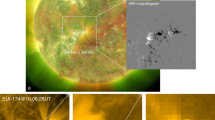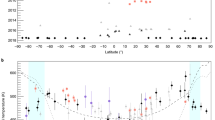Abstract
Saturn’s ionosphere is produced when the otherwise neutral atmosphere is exposed to a flow of energetic charged particles or solar radiation1. At low latitudes the solar radiation should result in a weak planet-wide glow in the infrared, corresponding to the planet’s uniform illumination by the Sun2. The observed electron density of the low-latitude ionosphere, however, is lower and its temperature higher than predicted by models3,4,5. A planet-to-ring magnetic connection has been previously suggested, in which an influx of water from the rings could explain the lower-than-expected electron densities in Saturn’s atmosphere6,7,8. Here we report the detection of a pattern of features, extending across a broad latitude band from 25 to 60 degrees, that is superposed on the lower-latitude background glow, with peaks in emission that map along the planet’s magnetic field lines to gaps in Saturn’s rings. This pattern implies the transfer of charged species derived from water from the ring-plane to the ionosphere, an influx on a global scale, flooding between 30 to 43 per cent of the surface of Saturn’s upper atmosphere. This ring ‘rain’ is important in modulating ionospheric emissions and suppressing electron densities.
This is a preview of subscription content, access via your institution
Access options
Subscribe to this journal
Receive 51 print issues and online access
$199.00 per year
only $3.90 per issue
Buy this article
- Purchase on Springer Link
- Instant access to full article PDF
Prices may be subject to local taxes which are calculated during checkout



Similar content being viewed by others
References
Stallard, T. S. et al. Temperature changes and energy inputs in giant planet atmospheres: what we are learning from H3+. Phil. Trans. R. Soc. 370, 5213–5224 (2012)
Miller, S., Stallard, T., Melin, H. & Tennyson, J. H3+cooling in planetary atmospheres. Faraday Discuss. 147, 283–291 (2010)
Atreya, S. K., Donahue, T. M., Nagy, A. F., Waite, J. H., Jr & McConnell, J. C. Theory, measurements, and models of the upper atmosphere and ionosphere of Saturn. In Saturn from Cassini-Huygens (eds Dougherty, M., Esposito, L. & Krimigis, S.) 239–277 (Springer, 1984)
Smith, C. G. A., Aylward, A. D., Millward, G. H., Miller, S. & Moore, L. E. An unexpected cooling effect in Saturn’s upper atmosphere. Nature 445, 399–401 (2007)
Moore, L., Mueller-Wodarg, I., Galand, M., Kliore, A. & Mendillo, M. Latitudinal variations in Saturn’s ionosphere: Cassini measurements and model comparisons. J. Geophys. Res. 115 A11317, http://dx.doi.org/10.1029/2010JA015692 (2010)
Connerney, J. E. P. & Waite, J. H. New model of Saturn’s ionosphere with an influx of water from the rings. Nature 312, 136–138 (1984)
Connerney, J. E. P. Magnetic connection for Saturn’s rings and atmosphere. Geophys. Res. Lett. 13, 773–776 (1986)
Wilson, G. R. & Waite, J. H., Jr Kinetic modeling of the Saturn ring-ionosphere plasma environment. J. Geophys. Res. 94, 17287–17298 (1989)
McLean, I. S. et al. in Society of Photo-Optical Instrumentation Engineers (SPIE) Conference Series Vol. 3354 (ed. Fowler, A. M.) 566–578 (SPIE, 1998)
Northrop, T. G. & Hill, J. R. Stability of negatively charged dust grains in Saturn's ring plane. J. Geophys. Res. 87, 6045–6051 (1982)
Northrop, T. G. & Hill, J. R. The inner edge of Saturn’s B ring. J. Geophys. Res. 88, 6102–6108 (1983)
Burton, M. E., Dougherty, M. K. & Russell, C. T. Saturn’s internal planetary magnetic field. J. Geophys. Res. 37, 24105 (2010)
Luhmann, J. G., Johnson, R. E., Tokar, R. L., Ledvina, S. A. & Cravens, T. E. A model of the ionosphere of Saturn’s rings and its implications. Icarus 181, 465–474 (2006)
Coates, A. J. et al. Plasma electrons above Saturn’s main rings: CAPS observations. Geophys. Res. Lett. 32 L14S09, http://dx.doi.org/10.1029/2005GL022694 (2005)
Miller, S. et al. H3+: the driver of giant planet atmospheres. Phil. Trans. R. Soc. Lond. 364, 3121–3137 (2006)
Mendillo, M. et al. Effects of ring shadowing on the detection of electrostatic discharges at Saturn. Geophys. Res. Lett. 32 L14S09, http://dx.doi.org/10.1029/2004GL021934 (2005)
Yelle, R. V. & Miller, S. in Jupiter: the Planet, Satellites and Magnetosphere (eds Bagenal, F., Dowling, T. & McKinnon, W.) 185–218 (Cambridge Univ. Press, 2004)
Lillie, C. F., Hord, C. W., Pang, K., Coffeen, D. L. & Hansen, J. E. The Voyager mission photopolarimeter experiment. Space Sci. Rev. 21, 159–181 (1977)
Acknowledgements
The data presented here were obtained at the W.M. Keck Observatory, which is operated as a scientific partnership among the California Institute of Technology, the University of California and NASA. The observations were made to support the Cassini auroral campaign. Ring profile data were provided by the Planetary Rings Node website18. Discussions within the international team led by T.S.S. on ‘Comparative Jovian Aeronomy’ have greatly benefited this work; this was hosted by the International Space Science Institute (ISSI). The UK Science and Technology Facilities Council (STFC) supported this work through the PhD Studentship of J.O’D. and grant support for T.S.S., H.M. and G.H.J.
Author information
Authors and Affiliations
Contributions
J.O’D. analysed and interpreted the data and wrote the paper. T.S.S., S.M. and K.H.B. proposed and designed the study and collected the data. H.M. greatly aided the analysis and interpretation of data. S.W.H.C. provided the magnetic-mapping model and magnetospheric information. G.H.J. provided ring-plane information. J.S.D.B. provided context from Cassini VIMS observations. All authors assisted in the interpretation of data and commented on the manuscript.
Corresponding author
Ethics declarations
Competing interests
The authors declare no competing financial interests.
Supplementary information
Supplementary information
This file contains Supplementary Text and Data 1-3 comprising: 1 Observational information, which elaborates on the details of the observations used to make the data; 2 Magnetic mapping Information, which discusses the details of the magnetic mapping used and also examines another leading magnetic field model as an alternative; and 3 Data, which shows the additional data plots. Supplementary Figures 1-9 are also included. (PDF 532 kb)
Rights and permissions
About this article
Cite this article
O’Donoghue, J., Stallard, T., Melin, H. et al. The domination of Saturn’s low-latitude ionosphere by ring ‘rain’. Nature 496, 193–195 (2013). https://doi.org/10.1038/nature12049
Received:
Accepted:
Published:
Issue Date:
DOI: https://doi.org/10.1038/nature12049
This article is cited by
-
Detection of the infrared aurora at Uranus with Keck-NIRSPEC
Nature Astronomy (2023)
-
Saturn’s near-equatorial ionospheric conductivities from in situ measurements
Scientific Reports (2020)
-
A pole-to-pole pressure–temperature map of Saturn’s thermosphere from Cassini Grand Finale data
Nature Astronomy (2020)
-
Cassini Exploration of the Planet Saturn: A Comprehensive Review
Space Science Reviews (2020)
-
Circumplanetary Dust Populations
Space Science Reviews (2019)
Comments
By submitting a comment you agree to abide by our Terms and Community Guidelines. If you find something abusive or that does not comply with our terms or guidelines please flag it as inappropriate.



